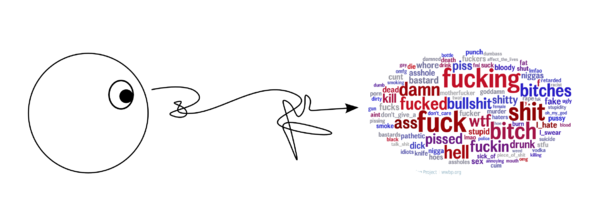I-could-have-written-that: Difference between revisions
No edit summary |
No edit summary |
||
| Line 2: | Line 2: | ||
|Creator=Manetta Berends | |Creator=Manetta Berends | ||
|Date=2016 | |Date=2016 | ||
|Bio=Manetta Berends (1989 | |Bio=Manetta Berends (1989) has been educated as a graphic designer at ArtEZ, Arnhem before starting her master-education at the Piet Zwart Institute (PZI), Rotterdam. From an interest in linguistics, code and a research based design practice, she currently works on the systemization of language in the field of natural language processing and text mining. | ||
|Thumbnail=I-could-have-written-that these-are-the-words mb.png | |Thumbnail=I-could-have-written-that these-are-the-words mb.png | ||
|Website=http://pzwart1.wdka.hro.nl/~manetta/i-could-have-written-that/ | |Website=http://pzwart1.wdka.hro.nl/~manetta/i-could-have-written-that/ | ||
|Description= | |Description=The large amount of digital text available these days, is presented as the problem that text mining can solve. Written language from social media users, product reviews and even essays from students are turned into data. Text mining is excecuted with untenable enthusiasm and a strong belief in the reading abilities of a text mining system. However, an actual text mining process is messy and chaotic. Altough the eventual results are presented as being read or mined from the text, they show more similarities to something that is written. This research project shows how the software, workprocess and vocabulary construct text mining results. | ||
}} | }} | ||
[[File:Perceiving-a-wordcloud.png|600px]] | [[File:Perceiving-a-wordcloud.png|600px]] | ||
Revision as of 23:46, 17 May 2016
| I-could-have-written-that | |
|---|---|
| Creator | Manetta Berends |
| Year | 2016 |
| Bio | Manetta Berends (1989) has been educated as a graphic designer at ArtEZ, Arnhem before starting her master-education at the Piet Zwart Institute (PZI), Rotterdam. From an interest in linguistics, code and a research based design practice, she currently works on the systemization of language in the field of natural language processing and text mining. |
| Thumbnail | |
| Website | http://pzwart1.wdka.hro.nl/~manetta/i-could-have-written-that/ |
The large amount of digital text available these days, is presented as the problem that text mining can solve. Written language from social media users, product reviews and even essays from students are turned into data. Text mining is excecuted with untenable enthusiasm and a strong belief in the reading abilities of a text mining system. However, an actual text mining process is messy and chaotic. Altough the eventual results are presented as being read or mined from the text, they show more similarities to something that is written. This research project shows how the software, workprocess and vocabulary construct text mining results.


